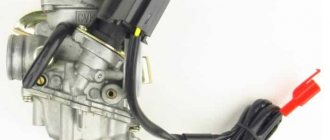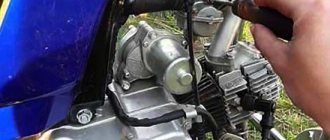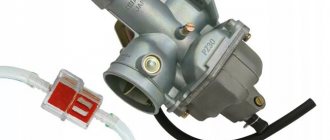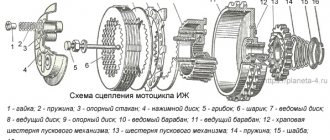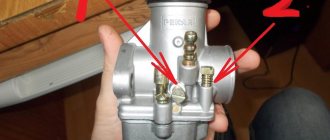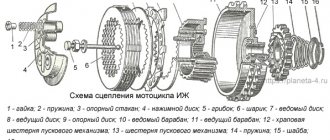Jupiter 5 is one of the most successful creations of Soviet motorcycle production. Today, like 30 years ago, the device is often found on the streets of both remote outbacks and large cities, and, in most cases, the owner prefers to handle its maintenance independently.
The carburetor, being one of the most important components of any motor vehicle, is subject to intensive use and increased wear. Considering the great age of some models, replacing this module very often becomes an inevitable condition for extending the life of the unit.
The motorcycle is equipped with Izhevsk carburetors K-62D, K-65D, K-68D , or the Czechoslovak model Jikov-2928SE . There are few differences between the first two options: the design of the top cover; enrichment jet diameter; needle fastening (K-65D comes with a nozzle). The K-68D differs from its predecessor:
- Enlarged diffuser.
- A round (not square, like the K-65) damper.
- Lateral (more convenient for optimization) location of the idle screw.
- Threaded (for quick needle adjustment) top cover.
Which carburetor is better to install on IZ Jupiter 5? As you can see, the 68th model is more convenient to maintain , however, experienced motorcyclists note that it often contains defects, for example, in the form of the absence of a hole that improves the formation of the fuel mixture.
Jikov-2928CE is considered a higher quality carburetor, but also more difficult to operate and repair. Therefore, when choosing this option, you should prepare for possible difficulties, for example, when searching for replacement jets, because their size is much smaller than those from Izhevsk.
Rice. Carburetor K-62:
1 — idle fuel jet, 2 — main fuel jet; 3 — float chamber, 4 — sprayer; 5 — float axis, 6 — float lever bushing; 7 — air channel, 8 — nozzle, 9 — dosing needle, 10 — body; 11 — throttle, 12 — needle lock; 13 — throttle spring; 14 — throttle lift limiter (removed after engine break-in); 15 — throttle control cable, 16 — rod with idle speed adjustment screw (lowering the throttle); 17 - cover; 18 — idle speed adjusting screw, 19 — fuel inlet fitting, 20 — adapter hole, 21 — idle speed emulsion channel; 22 — drainage hole, 23 — idle air channel, 24 — locking needle with washer, 25 — float, 26 — corrector emulsion channel; 27 — dosing needle; 28 — float stopper, 29 — plunger, 30 — plunger spring, 31 — corrector control cable
What kind of carburetor is used on the Izh Planet-5 motorcycle
The latest Planet model was produced in several variations. Early transitional models were equipped with K-62I carburetors. Then they began to install the K-65I and the more progressive K-68I with a cylindrical throttle valve.
All three carburetors: top left - K62I, top right - K68I, bottom - K65I
All three carburetors have a similar operating principle. From the tank, through the fuel valve, fuel enters the float chamber. The floats are made of petrol-resistant lightweight material. As soon as gasoline fills the chamber, the floats will float up and the shut-off needle will block the fuel supply channel.
From the chamber, fuel enters the atomizer through the main fuel jet. In it, the fuel is mixed with air entering through a special hole in the atomizer body. The finished mixture enters the mixing chamber (diffuser) and then into the engine cylinder. This dosing system is called the main one. And it only works at medium and high engine speeds, when the throttle is raised more than 2/3 of its stroke.
To operate the engine at low speeds, the carburetor is equipped with an idle system. It consists of a fuel tube, mixture quantity and quality screws, a special air channel, transition and idle holes in the diffuser.
The fuel rises through the tube due to the vacuum in the mixing chamber and is mixed with air entering through the air channel. As a result, the resulting mixture, when the throttle is opened slightly, exits through the idle hole (it is specially located behind the throttle valve, at the end of the diffuser).
If you continue to raise the throttle, the vacuum will increase in the area of the transition hole and the mixture will also begin to flow through it. In general, when you lift the throttle (turn the throttle lever), the mixture becomes leaner and the engine speed increases. The air flow speed increases and, by lowering the pressure in the mixing chamber, the fuel supply increases.
The carburetor of the Izh Planeta-5 motorcycle also contains an engine starting and warming up system (to facilitate engine starting in the cold season). The enrichment corrector is installed on the carburetor body or brought to the motorcycle handlebar using a cable. When it is lifted, 3 channels will open in the carburetor body. Through the fuel channel from the float chamber, the fuel will enter a special cavity, where it will mix with air coming from the air channel (this channel is usually located at the end of the diffuser on the air filter side).
As a result, the finished mixture will flow through a special channel to the outlet of the mixing chamber (behind the throttle valve). The channels are designed in such a way that the finished quality of the mixture is sufficient to warm up the engine.
Float stopper or additional starting device. When you press it, the floats lower and additional fuel enters the chamber. When starting, the mixture is richer and the engine starts easier. It is recommended to use the drowner only at temperatures of +5 C and below.
Adjusting the K-68 carburetor on the IZH Planet-5 motorcycle
The K-68I carburetor was installed on the Izh Planet-5 motorcycle more often than others. With proper setup and proper care, the motorcycle starts quickly, runs smoothly and without complaints.
To adjust the K-68I carburetor you will need a flat-head screwdriver, pliers, and a ruler. For clarity and ease of adjustment, use the K-68 carburetor diagram.
Algorithm for adjusting the Izh Planeta-5 carburetor:
- The first step is to check the fuel level in the float chamber. Unscrew the camera cover bolts with a screwdriver and remove it. Turn the carburetor over and use a ruler to measure the distance from the carburetor body to the top edge of the floats. It should be 26 ± 5 mm. If the parameters deviate, the tongue of the floats is bent in the appropriate direction using pliers. At the same time, in no case should the parallelism of the floats be disrupted.
- Set a gap of 2 mm between the throttle valve and the bottom of the mixing chamber by adjusting screw 11. Then check the position of the throttle needle. The required needle position is the middle groove. The remaining grooves are made to move the needle lock and adjust the appropriate fuel quality depending on climatic conditions.
- After all the above steps, we proceed to the most important stage - setting the idle speed. The idle quality adjusting screw 15 (located vertically on the left side of the carburetor) is screwed in until it stops, and then unscrewed 1-1.5 turns. Start the engine and warm up for 5 minutes. Using the mixture quantity adjustment screw 11 (located horizontally on the left side of the carburetor), we set the minimum stable engine speed. At the same time, slowly unscrew screw 15 until the engine speed stops increasing. It is the moment of reducing the crankshaft speed that will be optimal for determining the position of the adjusting screw 15. We again reduce the engine speed with screw 11 and unscrewing screw 15, we find a new optimal position of the throttle valve. This operation must be repeated until the minimum, but at the same time stable, engine crankshaft speed is established.
- By sharply turning the throttle lever at idle, we check the correctness of the adjustment (the quality of the mixture). If, when the throttle is opened sharply, the engine stalls or picks up speed poorly, screw 15 needs to be tightened a little, thereby enriching the mixture. If the engine stalls when the throttle is closed, screw 15 should be unscrewed slightly.
- You can also check the correctness of the adjustment by the color of the central insulator of the spark plug. After adjusting the carburetor, drive a motorcycle for a distance of 5-10 km and remove the spark plugs from the cylinder head. Dark carbon deposits indicate that the mixture is too rich. A light color (whitish or sandy) indicates that the mixture is poor. The normal recommended candle color is brown or brick.
- It is also worth remembering that the free play of the throttle cable is 1-3 mm. If it is not there, the throttle adjustment will be incorrect. The free play is set by adjusting a special bolt located under cap 18.
Carburetor characteristics for 68
Owners of motorcycles that were produced in Soviet times often use the K-68 Pekar carburetor. This equipment is produced in the city of St. Petersburg. Basically, such products were installed on various domestic vehicles.
| Carburetor | Vehicle | Engine | Nominal diffuser diameter (mm) | Mixing chamber diameter (mm) | Fuel jet flow rate (ml/min) |
| K68A | motorcycle IZH-6.113-03 | IZH-6.11-03 | 28 | 31,5 | 250 |
| K68D | motorcycle "IZH-Jupiter" | IZH-Yu5 | 28 | 31,5 | 250 |
| K68I | motorcycle "IZH-Planet" | IZH-P5, -7.107-10 | 32 | 35 | 280 |
| K 68 M | motorcycle IZH-6.302 | IZH-8.802 | 32 | 35 | 320 |
| K68R | Snowmobile "Lynx" | 440.76, 440.83 | 32 | 35 | 370 |
| K 68 T | Motorcycle "Ural" | IMZ-8.128 | 28 | 31,5 | 220 |
| K68 U | motorcycle 'Ural' | IMZ-8.123 | 28 | 31,5 | 190 |
| K68CH | motorcycle "IZH-Chopper" | IZH-6.113-05 | 28 | 31,5 | 240 |
The series called “Baker” contained a large number of diverse devices. Carburetors of this type were most often found in cars, as well as in motorcycles. For several years now, the demand for these products has not decreased. This happens because equipment of this type has high functional characteristics. These mechanisms are also quite economical.
The K-68 type carburetor is in great demand among car owners. This happens due to a number of reasons. For example, with proper adjustment of this carburetor, gasoline consumption can be reduced by up to 20 percent. In this case, the performance characteristics of the motor will increase significantly. The carburetor from this series also has acceptable performance properties. This mechanism has another significant advantage - its price. It is these characteristics that make this carburetor competitive with others.
Carburetor repair
When using the motorcycle for a long time, you may encounter carburetor overflow (leakage from the drain hole). First of all, it is recommended to check the fuel level in the carburetor and the tight fit of the shut-off needle. By bending the locking needle brackets in the desired direction, we adjust the fuel level (the distance from the plane of the middle of the floats to the edge of the carburetor body is 13±1.5 mm). The tapered end of the locking needle is made of rubber. If it becomes leaky, it is recommended to replace it with a new needle from the repair kit. It also happens that the floats begin to leak gasoline due to fatigue of the material. It can also be treated by replacement.
Floats
Fuel nozzles become clogged due to low-quality fuel or when dirt gets in from the air through the filter. To clean gasoline, in addition to the mesh in the fuel tap, you need to additionally cut the fuel filter into the gas hose. The air filter must be tightly connected to the carburetor. At the same time, you cannot change its design, much less install a so-called zero.
The filter element must strictly comply with the throughput recommended by the motorcycle manufacturer. Never use needles or wire to clean the jets. It is enough to wash them in gasoline and blow them with compressed air.
Which carburetor is better to put on Planet 5 instead of the original one?
If desired, imported Japanese Mikuni carburetors with diffuser diameters of 30 and 32 mm can be installed on Izh Planet-5 motorcycles. Naturally, you need to select jets recommended by the manufacturer. On Planet-5, the throughput of the main fuel jet corresponds to 270 ml/min, the corrector fuel jet is 255 ml/min.
You will also need to select an adapter to connect the carburetor flange to the cylinder. You can order an adapter from a turner or select one from other motorcycle models. The inlet window of the diffuser on Mikuni is wide, so the rubber pipe for connecting to the air filter will also need to be selected.
It is important to remember that all connections must be tight, without distortions.
The diameters of the diffuser and the cylinder inlet must be the same and have no steps that prevent the mixture from entering the combustion chamber.
This is what the installed Mikuni carburetor looks like on the Izh Planet-5 motorcycle.
All of the above also applies to the installation of a Chinese PZ 30 carburetor on the Izh Planet-5 motorcycle. Its special feature is the presence of a version with an accelerator pump, which helps enrich the mixture at high engine speeds. But to use it, you need an additional cable that will work in tandem with the motorcycle’s gas handle.
With minor modifications, the carburetor flange fits well with the mountings to the cylinder pipe. An important point is that you need to install a rubber or textolite gasket between the pipe and the flange so that the carburetor does not heat up when the engine is running.
This is what the installed PZ30 carburetor looks like on the Izh Planet-5 motorcycle.
Imported carburetors are good because they do not have the usual suction. To start the motorcycle, you do not need to fill the crankcase with gasoline; you just need to open the enrichment corrector. These carburetors also have regular drain holes instead of a drain hole, which are fitted with hoses that can be taken out to any convenient place. For example, under a motorcycle engine, so that if the carburetor overflows, nothing will get dirty.
How to install a carburetor
Before installing the carburetor on IZ Jupiter 5, make sure it is completely clean and all parts are present. First, remove the carburetor cover with the three-hole throttle body. The round hole located in the center is intended for placing and fixing the needle, the shaped one, located on the side of the cutout, is for attaching the cable coming from the throttle handle, the T-shaped one is for installing the screw rod. The new carburetor on the IZH Jupiter 5 has a limiter located in the cover, which is removed after the break-in period.
Carburetor of Izh Planeta 3.4 motorcycles
Izh Planet-3 motorcycles were equipped with K-62P and K-36I carburetors. The latter had a unique design for its time. The throttle shape was U-shaped, which made it possible to significantly reduce the dimensions of the carburetor (in comparison with the K-28 and K-37 produced at that time). The corrector was moved out of the diffuser area and regulated not the air, but the fuel. This solution made it possible to reduce fuel consumption by 4-6% due to more stable mixture adjustment.
The mixing chamber cover was fastened with special locking springs, which made it possible to quickly and conveniently replace the throttle cable or rearrange the needle. The main fuel jet was screwed into the bottom of the carburetor next to the drain plug. To clean it, it was not necessary to dismantle the carburetor. The diameter of the diffuser of the K-36I carburetor at the outlet is 28 mm, and in the middle it is 26 mm. That is, the mixing chamber is a kind of aerodynamic profile, which has a beneficial effect on mixture formation.
Another feature of the K-36 carburetor is its operating principle, which is similar to a car carburetor. The screw for the amount of mixture in it regulates not the air, but the fuel emulsion entering behind the throttle. Due to this, the sensitivity of the carburetor settings at idle has increased. Adjustment is carried out with screw 1 for the quantity of the mixture (at an angle) and screw 2 for the quality.
The K-36 carburetor has one drawback. It is sensitive to road dust. The upper latches do not seal the lid of the mixing chamber tightly and dust particles get there, the valve begins to jam and wear out. That is why motorcycles on which such carburetors were installed (Kovrovets, Izh Planeta-3, etc.) were equipped with carburetor protective covers.
Carburetor of Izh Planet Sport motorcycle
Motorcycle Izh Planet Sport 350. A legend of the Soviet motorcycle industry. Early models of the motorcycle were equipped with Japanese components, in particular a Mikuni carburetor with a diffuser diameter of 32 mm. Thanks to him, the motorcycle's power was 32 hp. at 6700 rpm.
The reliability of the carburetor is explained by the simplicity of the design. The throttle has a cylindrical shape. To drain excess fuel, there is a special plug at the bottom of the float chamber. The carburetor is adjusted using an air screw and an idle screw (similar to the K-68). To make starting the engine easier in cold weather, there is an enrichment lever.
Later versions of the motorcycle began to be equipped with the domestic K-62M carburetor. The engine power with it dropped to 28 hp.
As you can see, different carburetors were installed on Izh motorcycles of the Planet line, but mostly domestic ones. As engine power increased, the characteristics of carburetors also changed. For high-quality and long-term engine operation, it is necessary to inspect and clean the carburetor in a timely manner (every 3000-4000 km). If desired, imported carburetors can be installed on Izh Planet motorcycles. The main thing is to choose the right jets with the required throughput and match the diameter of the diffuser.
The carburetor is one of the main components of a motorcycle, which affects the operation of your bike’s engine. Its correct adjustment affects how it starts, runs, and engine power. The second element is the ignition system. In this article we will talk about adjustments that can be found on motorcycles Minsk, IZH Jupiter and Planet, Voskhod.
The K62 carburetor has two adjusting screws, with which you can change the idle speed, and a needle, by changing the position of which, you can change the property of the mixture (enrich or lean it). When we raise the needle, we enrich the mixture; when we lower it, we make it leaner. Adjusting the quality of the mixture is carried out by walking 2-3 km (at a speed of about 60-70 km/h) and looking at the spark plug. If the candle is covered with the working mixture (the candle is oily, dark brown or black), we lower the needle; if it is too dry (the color is white, light straw), we raise it. As a result, a light brown soot should appear. But this is just part of the adjustment; each time you need to set the carburetor idle speed. So we continue to adjust further:
To adjust the idle speed on the K62 carburetor there is a “quality screw”. This screw supplies air even when the throttle is closed. We repeat, the propeller produces air, although some people think that this propeller is designed for fuel. Therefore, by tightening the quality screw, we close the air flow, that is, we enrich the mixture. If we unscrew the screw, the mixture becomes leaner. As was said, this screw provides air in all positions of the damper, and therefore at idle speed of the crankshaft. Therefore, the quality screw belongs to the idle air regulator. At this moment, it significantly affects the operation, but if the gas is at medium or high speeds, then the influence is not large, but it is present. So, it all comes down to the fact that the idle speed is adjusted, and this automatically affects all engine frequencies. Now, after a short introduction, let’s talk about the idle speed adjustment itself. To keep things simple, let’s talk about adjusting K62 K carburetors and similar ones for Minsk and Voskhod motorcycles. But by analogy, the adjustment of all types of carburetors is the same, so it will also work on IZH and other motorcycles.
Remember that carburetor adjustment always takes place on a warm engine. When the warm-up is done, we begin the adjustment. First, tighten the quality screw to the maximum and unscrew it halfway - one turn. Next, we start the motorcycle and lower the throttle completely with the upper idle screw, then, by unscrewing it, we achieve the minimum stable speed. Next, by unscrewing the quality screw little by little, we achieve maximum speed; when, after further unscrewing, the speed drops, we screw it back to the same maximum and stability. It turned out that we set a stable idle speed at these minimum speeds. But the idle speed is most likely too high, so we lower the throttle with the upper screw, achieving even lower speeds. We tighten it down to the very minimum, when at even lower crankshaft speeds the motorcycle begins to stall. Having established the minimum at which the motorcycle still works, we repeat the procedure again with the quality screw. By screwing in and unscrewing the screw we achieve stability. Then we lower the damper again, making a higher minimum of crankshaft revolutions and so on until the crankshaft begins to operate at the lowest frequencies. When we have completed the adjustment, we can check the idle for stability. To do this, take and sharply turn the throttle to maximum and look at the speed at which the revolutions increase. After increasing, we sharply lower the gas and listen to the engine again. If the idle speed adjustment is done correctly, then with such a sharp increase and decrease in gases, the motorcycle engine should listen to the throttle at the moment and also sharply increase and decrease the crankshaft frequencies. When the engine lags, it means the adjustment is slightly incorrect. In such cases, you can try to do everything all over again, but you can simply add or reduce air at idle. If, with a sharp increase in gas, the engine does not respond immediately or even stalls, it means that the screw should be tightened ¼-½ turn. In case of poor performance in cases of sudden release of gas, the screw must be unscrewed ¼-½ turn.
Adjusting the K62 carburetor: 17 comments
Hello! Please tell me, I have a Minsk 125, it’s a Pakko (original, new), it’s not in use, it works fine, that is, the idle is normal, it picks up speed briskly, but as soon as you start to move out of place, it doesn’t pull well, or it may even stall, you just need gas open more than halfway. The quality screw is screwed in completely, but if you unscrew it by 1-1.5 rpm, you won’t be able to move it at all - the engine will stall. The spark is normal, the ignition is set correctly, the needle is in the middle position. Please tell me what’s wrong, this is the first time I’ve encountered such a problem?
Did you use the carburetor before or did you just install a new one?
I have an Izh P3 Minsk ignition that runs on a choke and doesn’t hold idle, and when you move from place to place, it’s like a splash, you add half the gas, then it goes, what’s wrong?
started a long time ago? CARBURETOR K 62? HOW DID YOU WORK BEFORE?
Former Leningrad carburetor, since 1993. began production of a new generation of motorcycle carburetors K-68. They were somewhat different from their predecessors in design terms, as well as in their functionality and efficiency. This model, in various modifications, began to be equipped with Ural, IZH, and Dnepr motorcycles. And today the K-68 has not lost its relevance and is rightfully considered one of the best domestic models for motorcycles.
In this article we will look at the main types of adjustment of the K-68 carburetor, with the help of which anyone can achieve good dynamics, efficiency and proper operation of the entire power unit. For those who do not know how to adjust the carburetor on a scooter, this article will also be useful.
Float chamber and its settings
Checking the fuel level in the float section is the first step when tuning the K-68 carburetor. To do this you need to choose the right tools. Thanks to them, you can pull out the carburetor and then remove the cover that covered the float chamber. After these steps, you need to position the carburetor so that the floats are at the top.
There should be a distance of approximately 26 millimeters from the top edge of the float to the edge of the body, but a deviation in different directions of up to 0.5 millimeters is possible. If the values are not similar, then the position of the floats should be corrected. This can be achieved by bending the tongue.
The floats must be parallel to each other. If this is not the case, then you can bend them with a bracket.
Basic types of carburetor settings
It is no secret to any car owner that the carburetor is designed to prepare a combustible mixture for the engine, which it produces by mixing a certain portion of air with fuel. But its functions are not limited to this. It must also ensure that the motorcycle engine operates in different modes, which means preparing a fuel mixture with different proportions of its components. The implementation of this task is entrusted to various systems and components of the device. These include:
- Main dosing system;
- Idle system;
- Starting device;
- System for maintaining a given fuel level.
We will look at setting up these elements. The best place to start is by checking the fuel level in the float chamber.
. To do this you need:
- remove the carburetor;
- remove the float chamber cover;
- Having turned the carburetor over so that the floats are on top, measure the distance from the edge of the body to the top edge of the floats. It should be 26 mm ± 0.5 mm; in case of deviation, it is eliminated by bending the tongue;
- check the parallelism of the floats; adjust by bending the brackets.
Now let's move on to the main dosing system.
. First, check the gap between the throttle valve and the bottom of the air duct. It should be 2 mm. If the gap does not match, then adjust it using the throttle valve cable adjusting bolt, which is located on the throttle well cover tube.
The next step in adjusting the K-68 carburetor is to check the position of the throttle needle
. It has 5 grooves into which the needle lock can be inserted. The normal position of the lock is the middle groove. Moving the lock downwards makes the mixture richer, upwards - on the contrary, it becomes leaner. We check by the color of the central electrode of the spark plug:
- if the electrode is black or dark brown, this means that the combustible mixture burning in the cylinder block is highly enriched - move the lock down;
- if the color is light gray, it is depleted - raise the lock;
- The light brown color of the electrode indicates the normal position of the needle.
Now the carburetor can be reinstalled and the idle speed can be adjusted.
. The adjustment is made on a hot engine, so you can drive 10 - 15 km before adjusting. Next, we make adjustments in the following order:
- We tighten the mixture quality screw until it stops, and then unscrew it one to one and a half turns;
- By rotating the throttle lift screw, we achieve a reduction in speed to the minimum stable;
- Using the quality screw, we bring the engine to maximum speed;
- Again, use the throttle lift screw to reduce the speed to minimum. This operation must be carried out several times until you achieve stable engine operation at the leanest possible mixture;
- Turn the quality screw ½ turn.
Finally, the K-68 carburetor has been adjusted. If everything is done correctly, then there is a full guarantee that with the remaining systems in working order and debugged, the motorcycle will start confidently and operate reliably in any mode, delivering true pleasure to its owner.
«>
Carburetor settings
K-68 carburetor diagram: 1. Thrust bolt of the cable sheath. 2. Mixture quality adjustment screw. 3. Throttle lift screw.
The K-68 carburetor model is quite often installed on motorcycles of domestic origin. Owners of this type of transport try to get only original spare parts produced at a plant in St. Petersburg.
The performance of the engine in various modes will depend on how the carburetor operates. Everyone knows that the fuel mixture must be prepared in certain proportions between air and gasoline. If this proportion is not calculated correctly, then there will be a disruption in other transport mechanisms. Therefore, control of the mixture creation must be carefully carried out by the driver.
To properly create fuel, you need to properly adjust specific devices. For example, a fuel dosing system. In addition to this, you should look at the operation of the starting device, as well as at the device that monitors the fuel level. Do not forget about adjusting the idle speed yourself.


